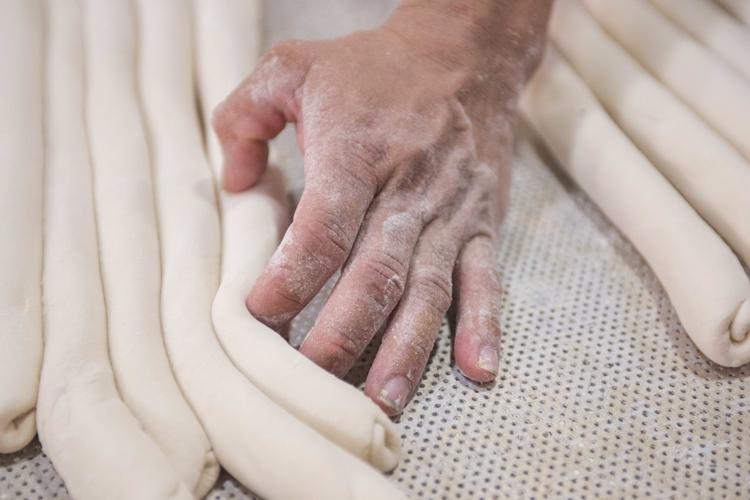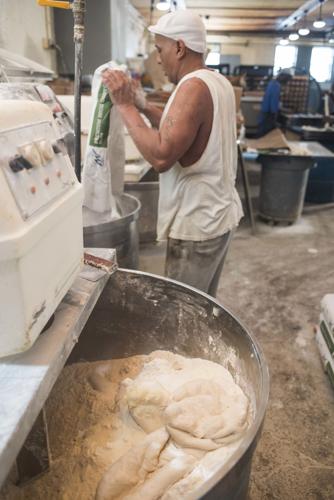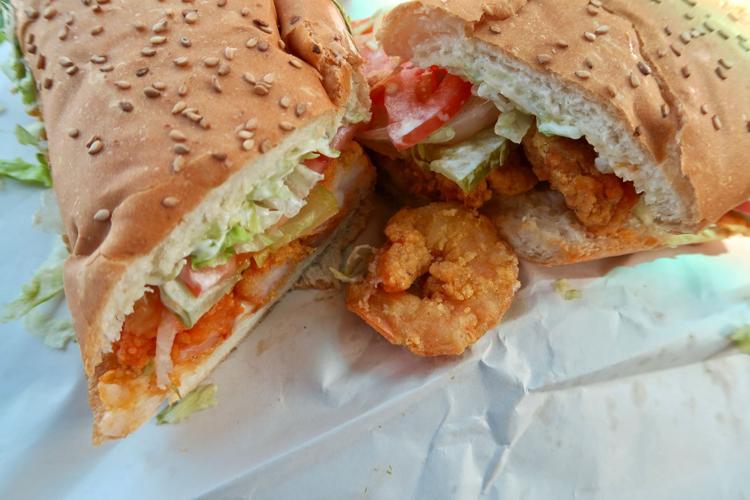They’re all bound to become po-boys, but as soon as the fresh loaves arrive at Mahony's in the French Quarter, they go straight to the vault.
That’s the bread vault, a snug concrete chamber built into the parking garage just past Mahony's kitchen. Behind its door, temperature and humidity are controlled and carefully monitored throughout the day.
It’s part of an elaborate protocol worked out at the eatery to maintain optimal conditions for this city’s humble, famously perishable, absolutely foundational po-boy bread. After all, there’s a lot riding on them.
“The bread to us is the stage,” said Glen Armantrout, who runs the two locations of Mahony's Original Po-Boys & Seafood. “Everything performs on that stage. It has to be exceptional every time someone comes here and bites into it.”

French bread cools at John Gendusa Bakery in New Orleans. They are bound for restaurants and po-boy shops around the city, on September 19, 2018.
Whether it’s fried oysters or shrimp, gravy-drenched roast beef or root beer-glazed ham, the po-boy starts with the bread. The particulars of its flavor, its texture, its aroma, even the sound of its crunch — all of this distinguishes the po-boy from any other sandwich. The bread makes the po-boy.
But who makes the bread?
Over a span of decades, the list of bakeries producing traditional po-boy bread has dwindled. In September, their ranks took a jolting hit when the Alois J. Binder Bakery shuttered after a long decline.
While the Binder family has not addressed their intentions for the business, the old bakery in Faubourg Marigny remains idle, and deliveries to restaurants and groceries abruptly ceased. City Hall is suing the bakery for back taxes.
That leaves practically all the production of traditional New Orleans po-boy bread in the hands of just two suppliers: Leidenheimer Baking Co. and the much smaller John Gendusa Bakery.
There are a few alternatives out there, including Cartozzo’s, a Kenner wholesaler that makes a hybrid loaf with longer shelf life. Cartozzo’s has restaurant customers, though its primary business is in supplying grocery store distributors, said proprietor Angelo Cartozzo. La Louisiane is another local wholesale supplier based in Harahan, producing bread next to its cakes and specialty desserts.
There is also bread from local Vietnamese bakeries, where the light, crisp-crusted loaves used for banh mi have similarities to the New Orleans classic. Dong Phuong, the area’s largest Vietnamese bakery, has seen an uptick in restaurant orders since Binder’s shut down, including from po-boy shops, company president Linh Garza said.
But for eateries determined to serve po-boys in the traditional style, there’s no question that this key component now rests on a narrowing base.
“I have to admit it’s getting a little scary,” said Al Hornbrook, who runs the three Parran’s Po-Boys restaurants. “What if someday, one of them says they’re not doing it anymore, or what if something happens? What happens if we only have one left?”
Crust and character
Traditional New Orleans po-boy bread stands in stark contrast to the revival of artisan baking now so evident around the country, and in New Orleans, with its focus on long fermentation, heirloom wheats and Old World character. Po-boy bread is a New Orleans character, one that developed here in the industrial age and evolved in step with the po-boy.
Nearly a yard long, the whole loaf yields multiple sandwiches. The sturdy crust stands up to gravy and mayo and the soft, airy interior compresses around the crispy edges of fried seafood. Po-boy bread does not just contain its fillings, it cradles them.
If Sam’s Po-Boys in Old Jefferson was a sitcom, the stars of the show would be Jackie Dupeire, her sister Jo Levatino Lund and their sister-in…
This bread is as essential to the flavor of New Orleans as roux. But while any respectable local cook can furnish a gumbo, keeping po-boy bread in circulation is a commercial undertaking.
Po-boy shops and restaurants need consistent supply and daily delivery to their kitchen doors. Bakeries need scale to stay viable with a profit margin measured in crumbs.
Bakers also need the expertise to create this distinctive New Orleans loaf, a skill not taught in any baking school.
“If I took a year, I still don’t think I could teach someone, even a younger version of me, everything you need to know to run this place,” said Jason Gendusa, fourth-generation proprietor of John Gendusa Bakery. “So much of it you learn along the way.”

Jason Gendusa lays out dough for the long po-boy loaves that are a specialty of his John Gendusa Bakery, on September 19, 2018. Gendusa is the fourth generation to run the family bakery, which first opened in 1922.
Gendusa’s bakery dates to 1922, when his great-grandfather, a Sicilian immigrant, first opened it in the Seventh Ward. It moved in 1996 to Gentilly, taking over a former hardware store.
Not much bigger than the po-boy shops it supplies, the John Gendusa Bakery is narrow, cramped, hot and heady with the malty smell of fresh bread. The crew here produces other types of bread, but the vast majority of the output is the long po-boy loaf. Most of the bakery's customers are restaurants.
Jason’s father, John Gendusa, 73, the grandson of the bakery’s namesake, is technically retired but remains a regular presence here.
“When baking is in your blood, you can’t help it,” he said.

Carlos Lopez forms French bread dough for baking at John Gendusa Bakery, one of the last suppliers of traditional New Orleans po-boy bread, on September 19, 2018.
Father and son tell strikingly similar stories about growing up in the bakery. John Gendusa recalls sitting on a steel drum as a pre-schooler, watching his father work. Jason remembers summer afternoons playing with his toys in piles of flour while the wheels of the bakery turned around him.
Later, as a teenager, whenever one of those wheels came loose late at night, his father would rouse him from bed to help him fix it, holding a flashlight, passing him tools.
“I was just a kid so I didn’t realize it, but all the time, I was learning the business,” said Jason Gendusa.
More than hands-on, the baking process for Gendusa is hands-in. At the mixer, he uses his fingers to feel the different batches of doughs, checking for a texture he finds hard to describe but still recognizes instantly.
“I can do this with my eyes closed, because it’s all about how it feels,” he said.

John Gendusa Bakery employees Kevin Edwards (left), Larry Varnado (right) and their co-workers at John Gendusa Bakery prepare French bread dough on September 19, 2018.
The bread sits in a cooling room to proof and later has a stint in the bakery’s steam room to absorb more moisture, all crucial steps to achieve the right texture. The dough hits the ovens in the dark wee hours the next morning, and by sunrise, delivery drivers are whisking the bread out the door in brown paper sacks the size of golf bags.
Gendusa said business has picked up a bit since Binder shut down, as that bakery’s former customers scrambled for a new supplier. The list of candidates was short.
Born and bread
Leidenheimer, across town in Central City, dates to 1896. It has outlived countless competitors, and acquired a few, too, including Reising’s.
Leidenheimer still bakes and markets Reising products, including its po-boy loaf. Company president Sandy Whann said he tried to arrange a similar business deal with Binder before it closed but was not successful.

Reising's bread, now produced by Leidenheimer Baking Co., sits on a grocery shelf next to Leidenheimer's own Zip bread.
Whann takes the long view on the gradual winnowing of the city’s traditional bakeries, pointing to a convergence of market dynamics and the challenges of family-run businesses.
Groceries were once a major customer for the city’s bakeries, and he said at one point, the local Schwegmann’s chain was Leidenheimer’s own largest account. But by the 1980s, many supermarkets developed their own in-house bakery departments, adding a new layer of competition.
Old city directories are filled with dozens and dozens of former bakeries, many of them bearing the German and Italian surnames of the families that ran them — Ancona, Bacher, Baehr, Bauer, Fuhr, Hoehn, Messina, Tortorich, Zengel, and on and on. But navigating family business succession generation after generation can be fraught.
“These aren’t businesses that can continue unless there’s another generation coming in that wants to take it on, and the fact is there are a lot easier ways to make money out there,” Whann said. “The opportunity to be part of the real culinary culture and heritage of this city, that’s what gets us out of bed in the morning.”
Whann, who worked at Leidenheimer with his father, notes that his own son, William, now a college senior, is being groomed to one day run the bakery.
Bread at its best
New Orleans po-boy bread itself is temperamental, with constant adjustments required at the bakery to account for temperature and humidity, changing with time of year and, sometimes, even time of day.
Still, Whann is upbeat about the future of the local food tradition he’s helped oversee all these years.
“There's a culture behind this bread, and if that continues to be showcased by our restaurants, nothing can stop it,” he said. “But it needs ongoing support. If there’s not enough business, it won’t matter if there are two bakeries or none. We have to earn our customers' trust, and the community has to support our customers. It’s great to say you love po-boys and the food culture, but if you only eat one every six or seven months, that’s probably not going to cut it.”
New Orleans po-boy bread is inextricably tied to place. Attempts to field credible po-boys away from New Orleans usually founder on the texture of the bread. Even shipping the genuine article from the city requires meticulous timing, said Lovey Wakefield, whose Elmwood company NOLA Cajun sends Louisiana food products across the globe. NOLA Cajun ships Reising's-brand bread, and Wakefield said the main customer base are New Orleans expats.
"People who aren't familiar with it don't understand it," she said. "But because it's so authentic and synonymous with New Orleans, there's still a lot of demand. People know there's no substitute."

A special at Mahony's Po-boys is an old-fashioned shrimp po-boy, finished with just pickles, lemon and butter.
At Mahony’s in the French Quarter, the bread vault was developed in the spirit of elevating the po-boy’s first ingredient, and it came after sit-down consultations with Leidenheimer’s own bakers.
“We wanted to know what went into baking it, what conditions effect it, and what we can do to make sure we’re serving the same bread at lunch and at dinner,” said Mahony's culinary director Casey Levy.
Like others around town, the restaurant gets two daily deliveries from Leidenheimer, in the morning and at mid-day. Leftovers become breadcrumbs for meatballs, croutons for salads and, in po-boy bread’s classic leap to immortality, bread pudding.
“This bread is so beautiful when it gets here in the morning,” said Armantrout. “We just have to do our best by it.”
This spring, Inglewood Farm brought in the first commercial harvest of organic wheat that Louisiana has seen for generations.
Around New Orleans, Dianne Sclafani’s last name is well known from the Italian restaurant her family ran for decades. Today, as a culinary bus…
A lighted sign outside the Alois J. Binder Bakery has long been a beacon for lovers of New Orleans po-boy bread. When the bulbs along its edge…

























































